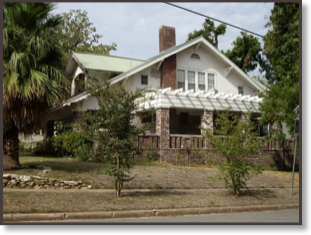Brady House - 1915

Stylistic influence(s): Bungalow, arts & crafts
Architect/Builder: Dennis R. Walsh, address at the time on Bee Caves Rd.
Historic Use: Residence
Current Use: Residence
Historic Use: Residence
Current Use: Residence
Historical designations:
City of Austin Historic Landmark
City of Austin Historic Landmark
Building History
John W. Brady (1869-1943) and this address are first listed in city directories in 1916. In 1920 he is indicated as the owner. From 1929-1940 he is listed with his wife Nellie (1876 - 1945), and his occupation is indicated as lawyer. John W. Brady is listed in 1906-07 as County Attorney (Brady & Caldwell), h 913 Colorado. 1910: special assistant attorney general, r 913 Colorado. 1914: Brady - (Lightfoot, Brady & Robertson) r. W. 6th; no listing for 1601 Pearl.
At one point the property was owned by a group of artists and entertainers called Imagine, Inc. Dee McCandless, a dance choreographer of some note, was among that group. “At that time, the house was divided into 12 rooms. The porches had been enclosed and a room had been added on the Southwest corner. The residents before that were a family named Butler. They lived here for over 20 years and raised a family in the house.
Significant Persons Associated with Building
1916-1945: Judge John W. Brady (1869-1943) had a much larger house behind this one at the corner of 16th and West where apartments now stand -- 1606 West, which had served as the home of John Chiles. He sold that house and built this one as a downsizing measure in 1916.
Brady was one of five children born in Austin to James and Agnes Brady. His father was a grocer, born in Ireland, and his mother was English. Brady received a law degree from UT in 1896. He began his career in a law partnership with E.B. Robertson of Fort Worth. Later, as county attorney of Travis County, Brady was the driving force behind the dissolution of the Standard Oil Company’s monopoly in Texas. The state of Texas awarded him $90,000.00 for the effort. He also worked as special counsel for Governor “Ma” Ferguson. Subsequently he became the assistant attorney general, served as an attorney for the State Banking Board, and was appointed justice of the 3rd Court of Civil Appeals in Austin (1918-1923), but was defeated for election in 1923.
At the age of 60, Brady helped secure a job at the state capitol for Lehlia Highsmith, a young stenographer for the Texas Commission of Appeals of the Texas Supreme Court. On November 9, 1929, Brady stabbed Highsmith to death in front of her boarding house located at 307 East 11th Street, Austin, TX. Brady was incarcerated that evening, tried and convicted of murder without malice, and sentenced to three years in prison of which he served only one and a half years.
John W. Brady (1869-1943) and this address are first listed in city directories in 1916. In 1920 he is indicated as the owner. From 1929-1940 he is listed with his wife Nellie (1876 - 1945), and his occupation is indicated as lawyer. John W. Brady is listed in 1906-07 as County Attorney (Brady & Caldwell), h 913 Colorado. 1910: special assistant attorney general, r 913 Colorado. 1914: Brady - (Lightfoot, Brady & Robertson) r. W. 6th; no listing for 1601 Pearl.
At one point the property was owned by a group of artists and entertainers called Imagine, Inc. Dee McCandless, a dance choreographer of some note, was among that group. “At that time, the house was divided into 12 rooms. The porches had been enclosed and a room had been added on the Southwest corner. The residents before that were a family named Butler. They lived here for over 20 years and raised a family in the house.
Significant Persons Associated with Building
1916-1945: Judge John W. Brady (1869-1943) had a much larger house behind this one at the corner of 16th and West where apartments now stand -- 1606 West, which had served as the home of John Chiles. He sold that house and built this one as a downsizing measure in 1916.
Brady was one of five children born in Austin to James and Agnes Brady. His father was a grocer, born in Ireland, and his mother was English. Brady received a law degree from UT in 1896. He began his career in a law partnership with E.B. Robertson of Fort Worth. Later, as county attorney of Travis County, Brady was the driving force behind the dissolution of the Standard Oil Company’s monopoly in Texas. The state of Texas awarded him $90,000.00 for the effort. He also worked as special counsel for Governor “Ma” Ferguson. Subsequently he became the assistant attorney general, served as an attorney for the State Banking Board, and was appointed justice of the 3rd Court of Civil Appeals in Austin (1918-1923), but was defeated for election in 1923.
At the age of 60, Brady helped secure a job at the state capitol for Lehlia Highsmith, a young stenographer for the Texas Commission of Appeals of the Texas Supreme Court. On November 9, 1929, Brady stabbed Highsmith to death in front of her boarding house located at 307 East 11th Street, Austin, TX. Brady was incarcerated that evening, tried and convicted of murder without malice, and sentenced to three years in prison of which he served only one and a half years.